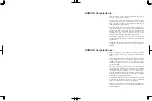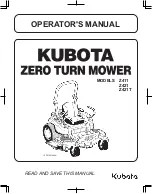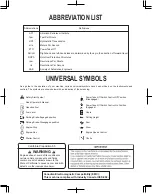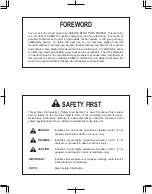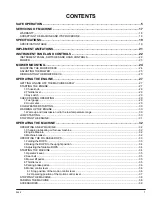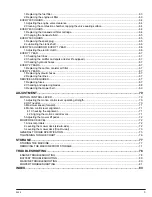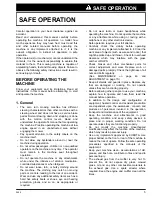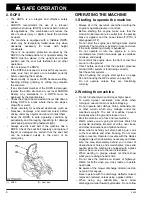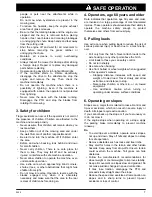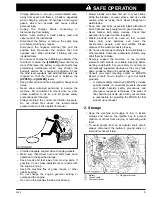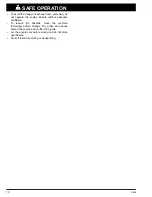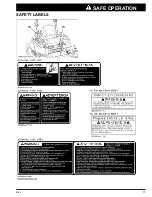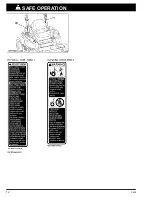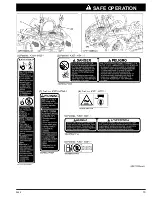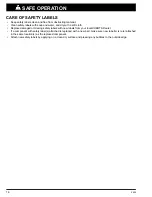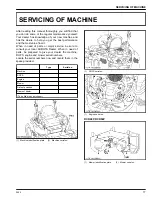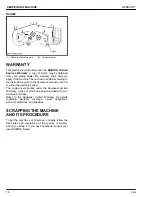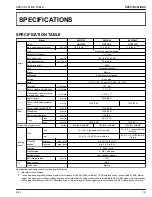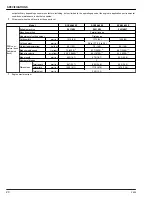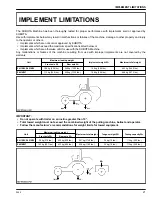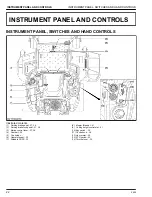
people or pets near the attachments while in
operation.
Do not mow when bystanders are present in the
mowing area.
• To reduce fire hazards, keep the engine exhaust
area free of grass or leaves.
• Be sure that the rotating blades and the engine are
stopped and the key is removed before placing
hands or feet near blades and cleaning blockages
or unclogging the chute. Keep hands and feet away
from the cutting units.
• Shut the engine off and wait for all movement to
stop before removing the grass catcher or
unclogging the chute.
• Maintain all screens to avoid overheating
conditions.
• Always inspect the mower for damage after striking
a foreign object. Repair or replace any damaged
parts before restarting.
• Operate during daylight or in bright artificial light.
• If the machine starts to vibrate abnormally,
disengage the drive to the attachments, stop the
engine and remove the key. Then check the
machine immediately.
• Do not operate the machine when there is a
possibility of lightning. Even if the machine is
equipped with a cabin, the operator is not protected
from lightning.
• Never raise the deck with the blades running.
Disengage the PTO and stop the blades from
rotating if not mowing.
3. Safety for children
Tragic accidents can occur if the operator is not alert of
the presence of children. Children are attracted to the
machine and mowing activity.
• Never assume that children will remain where you
last saw them.
• Keep children out of the mowing area and under
the watchful care of another responsible adult.
• Be alert and turn the machine off if children enter
the area.
• Before and when backing, look behind and down
for small children.
• Never carry children. There is no safe place for
them to ride. They may fall off and be seriously
injured or interfere with safe machine operation.
• Never allow children to operate the machine, even
under adult supervision.
• Use extra care when approaching blind corners,
shrubs, trees, or other obstructions that might hide
children from sight.
• Do not mow in reverse. Operate in reverse with the
blades engaged only when it is absolutely
necessary and make sure that the area to the rear
is clear of children before doing so.
4. Operators, age 60 years and older
Data indicates that operators, age 60 years and older,
are involved in a large percentage of machine-related
injuries. These operators should evaluate their ability to
operate the machine safely enough to protect
themselves and others from serious injury.
5. Pulling loads
Use extra care when pulling loads to reduce the risk of
serious personal injury or death due to a machine tip-
over.
• Pull only from the hitch. Never attach loads to the
axle housing or any other point above the hitch.
• Limit loads to those you can safely control.
• Do not turn sharply.
• Use care when backing.
• Use front ballast or wheel weights when suggested
in this operator's manual.
– Stopping distance increases with speed and
weight of towed load. Travel slowly and allow
extra time and distance to stop.
– Never allow children or others in, or on, towed
equipment.
– Use additional caution when turning or
operating under adverse surface conditions.
6. Operating on slopes
Slopes are a major factor related to loss-of-control and
tip-over accidents, which can result in severe injury or
death. All slopes require extra caution.
If you cannot back up the slope or if you feel uneasy on
it, do not mow it.
If the engine stops when operating on a slope, apply
the parking brake immediately to prevent machine
runaway.
Do
• To avoid tip-over accidents, operate across slopes,
not up and down. Stay off hills and slopes too steep
for safe operation.
• Remove obstacles such as rocks and tree limbs.
• Stay alert for holes in the terrain and other hidden
hazards. Keep away from drop-offs. Uneven terrain
could overturn the machine. Tall grass can hide
obstacles.
• Follow the manufacturer's recommendations for
wheel weight or counterweights to improve stability.
• Keep all movement on slopes slow and gradual. Do
not make sudden changes in speed or direction.
If tires lose traction, disengage the PTO and
proceed slowly straight down the slope.
• Reduce the speed and exercise extreme caution on
slopes and in sharp turns to prevent tip-over
accidents or loss of control.
SAFE OPERATION
Z400
7
Summary of Contents for Z411
Page 3: ...OPERATOR S MANUAL 1SFRT00108A01 READ AND SAVE THIS MANUAL MODELS Z411 Z421 Z421T ...
Page 9: ...4 Z400 ...
Page 16: ...SAFETY LABELS SAFE OPERATION Z400 11 ...
Page 17: ...SAFE OPERATION 12 Z400 ...
Page 18: ...SAFE OPERATION Z400 13 ...
Page 19: ...SAFE OPERATION 14 Z400 ...
Page 20: ...SAFE OPERATION Z400 15 ...
Page 53: ...PERIODIC SERVICE CHART LABEL MAINTENANCE PERIODIC SERVICE CHART LABEL 48 Z400 ...


